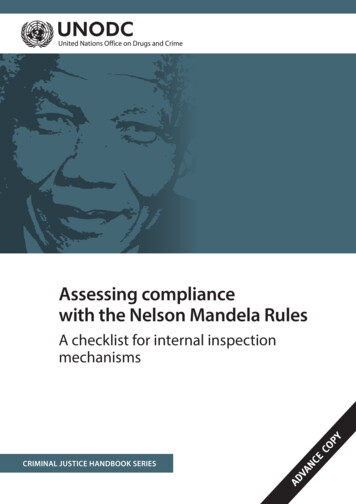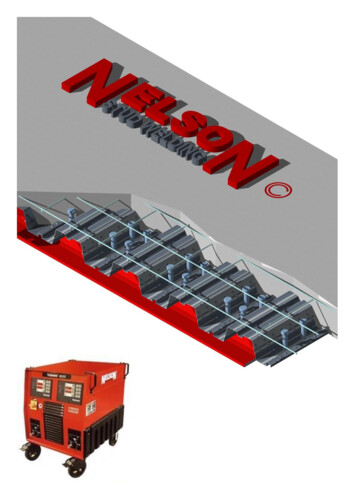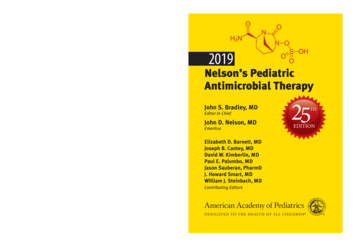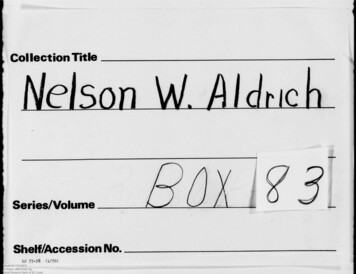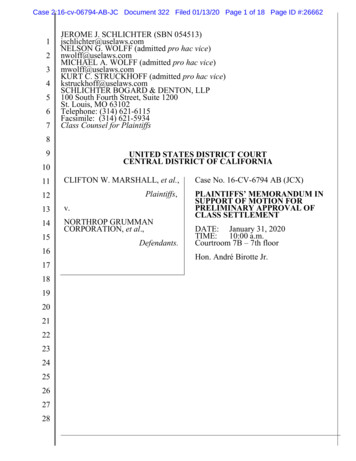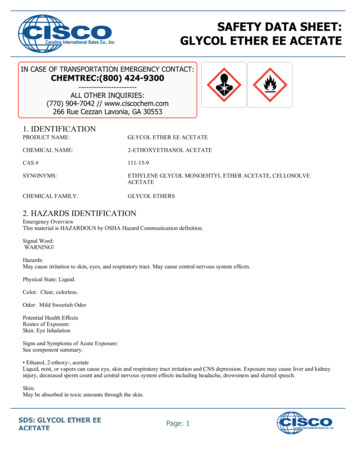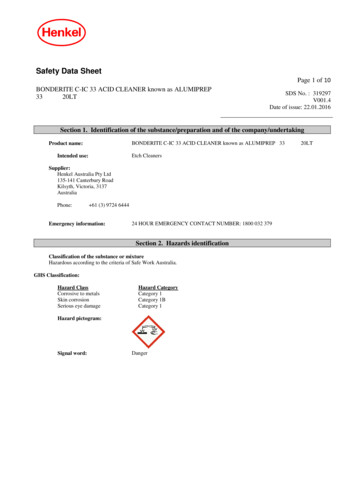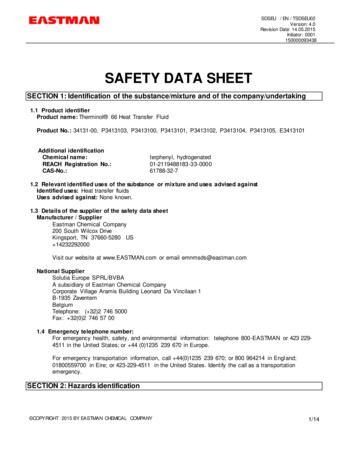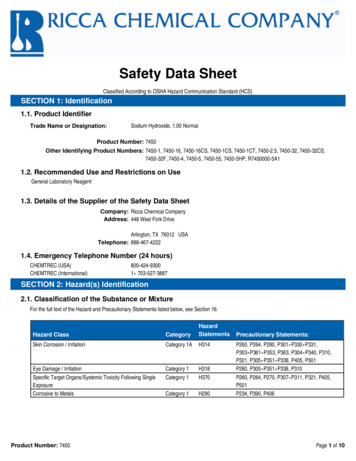
Transcription
Safety Data SheetClassified According to OSHA Hazard Communication Standard (HCS)SECTION 1: Identification1.1. Product IdentifierTrade Name or Designation:Sodium Hydroxide, 1.00 NormalProduct Number: 7450Other Identifying Product Numbers: 7450-1, 7450-16, 7450-16CS, 7450-1CS, 7450-1CT, 7450-2.5, 7450-32, 7450-32CS,7450-32F, 7450-4, 7450-5, 7450-55, 7450-5HP, R7450000-5A11.2. Recommended Use and Restrictions on UseGeneral Laboratory Reagent1.3. Details of the Supplier of the Safety Data SheetCompany: Ricca Chemical CompanyAddress: 448 West Fork DriveArlington, TX 76012 USATelephone: 888-467-42221.4. Emergency Telephone Number (24 hours)CHEMTREC (USA)CHEMTREC (International)800-424-93001 703-527-3887SECTION 2: Hazard(s) Identification2.1. Classification of the Substance or MixtureFor the full text of the Hazard and Precautionary Statements listed below, see Section 16.Hazard ClassCategoryHazardStatementsSkin Corrosion / IrritationCategory 1AH314Eye Damage / IrritationCategory 1H318Specific Target Organs/Systemic Toxicity Following SingleExposureCorrosive to MetalsCategory 1H370Category 1H290Product Number: 7450Precautionary Statements:P260, P264, P280, P301 P330 P331,P303 P361 P353, P363, P304 P340, P310,P321, P305 P351 P338, P405, P501P280, P305 P351 P338, P310P260, P264, P270, P307 P311, P321, P405,P501P234, P390, P406Page 1 of 10
Safety Data Sheet2.2. GHS Label ElementsPictograms:Signal Word:DangerHazard Statements:Hazard NumberH290H314H318H370Hazard StatementMay be corrosive to metals.Causes severe skin burns and eye damage.Causes serious eye damage.Causes damage to organs.Precautionary Statements:Precautionary NumberP234P260P264P270P280P301 P330 P331P303 P361 P353P304 P340P305 P351 P338P307 P311P310P321P363P390P405P406P501Precautionary StatementKeep only in original container.Do not breathe fumes, mist, vapors, or spray.Wash arms, hands and face thoroughly after handling.Do not eat, drink or smoke when using this product.Wear protective gloves and eye protection.IF SWALLOWED: rinse mouth. Do NOT induce vomiting.IF ON SKIN (or hair): Take off immediately all contaminated clothing. Rinse skin with water.IF INHALED: Remove person to fresh air and keep comfortable for breathing.IF IN EYES: Rinse cautiously with water for several minutes. Remove contact lenses, if present and easy to do. ContinIF exposed: Call a POISON CENTER or physician.Immediately call a POISON CENTER or physician.Specific treatment (Wash areas of contact with water immediately).Wash contaminated clothing before reuse.Absorb spillage to prevent material damage.Store locked up.Store in corrosive resistant container with a resistant inner liner.Dispose of contents in accordance with local, state, federal and international regulations.2.4. Hazards not Otherwise Classified or Covered by GHSData not available.Product Number: 7450Page 2 of 10
Safety Data SheetSECTION 3: Composition / Information on Ingredients3.1. Components of Substance or MixtureChemical NameWaterFormulaH₂OSodium HydroxideNaOHMolecular Weight CAS Number18.01 g/mol7732-18-539.99 g/mol1310-73-2Weight%96.183.82SECTION 4: First-Aid Measures4.1. General First Aid InformationEye Contact: IF IN EYES: Rinse cautiously with water for several minutes. Remove contact lenses, if present and easy to do. Continuerinsing. May cause irritation and burns.Inhalation: IF INHALED: Remove person to fresh air and keep comfortable for breathing.Skin Contact: IF ON SKIN (or hair): Take off immediately all contaminated clothing. Rinse skin with water. May cause irritation, redness, andpain.Ingestion: IF SWALLOWED: rinse mouth. Do NOT induce vomiting. Dilute with water or milk. Do not induce vomiting. Call a physician ifnecessary.4.2. Most Important Symptoms and Effects, Acute and DelayedCauses severe skin burns and eye damage. Causes serious eye damage. Causes damage to organs. Mildly corrosive, non-flammable, non-toxic.Wash areas of contact with water for at least 15 minutes. Call a physician if irritation develops. EYE CONTACT: May cause irritation and burns. SKINCONTACT: May cause irritation, redness, and pain. CHRONIC EFFECTS / CARCINOGENICITY: Prolonged or repeated exposure may causedermatitis.4.3. Medical Attention or Special Treatment NeededImmediately call a POISON CENTER or physician. Specific treatment (Wash areas of contact with water immediately).SECTION 5: Fire-Fighting Measures5.1. Extinguishing MediaUse any means suitable for extinguishing surrounding fire.5.2. Specific Hazards Arising from the Substance or MixtureNot considered to be a fire or explosion hazard.5.3. Special Protective Equipment for FirefightersUse protective clothing and breathing equipment appropriate for the surrounding fire.SECTION 6: Accidental Release Measures6.1. Personal Precautions, Protective Equipment and Emergency ProceduresWear protective gloves and eye protection.Product Number: 7450Page 3 of 10
Safety Data Sheet6.2. Cleanup and Containment Methods and MaterialsCollect liquid and dilute with water. Neutralize with dilute acid solutions. Release to drain if local regulations allow. For larger spills, absorb withsuitable material (vermiculite, clay, etc.). Collect the solid residue and save for disposal.SECTION 7: Handling and Storage7.1. Precautions for Safe Handling and Storage ConditionsStore in corrosive resistant container with a resistant inner liner. As with all chemicals, wash hands thoroughly after handling. Avoid contact with eyesand skin. Protect from freezing and physical damage. Do not mix with acids.SECTION 8: Exposure Controls / Personal Protection8.1 Control ParametersChemical NameLimit TypeCountry Exposure LimitInformation SourceSodium Hydroxide (1310-73-2)TWAUSA2 mg/m³ TWASodium Hydroxide (1310-73-2)TLV-CeilingUSA2 mg/m³ CeilingU.S. - OSHA - Final PELs - Time WeightedAverages (TWAs)ACGIH - Threshold Limit Values - Ceilings(TLV-C)8.2. Exposure ControlsEngineering Controls: No specific controls are needed. Normal room ventilation is adequate.Respiratory Protection: Normal room ventilation is adequate.Skin Protection: Wear protective gloves and eye protection. Chemical resistant gloves.Eye Protection: Wear protective gloves and eye protection. Safety glasses or goggles.8.3. Personal Protective EquipmentWear protective gloves and eye protection. Normal room ventilation is adequate. Chemical resistant gloves. Safety glasses or goggles.Product Number: 7450Page 4 of 10
Safety Data SheetSECTION 9: Physical and Chemical Properties9.1. Basic Physical and Chemical PropertiesAppearance: Colorless liquidPhysical State: LiquidOdor: OdorlessOdor Threshold: Data not available.pH: 13Melting/Freezing Point: Approximately 0 CInitial Boiling Point/Range: Approximately 100 C - Approximately 100 CFlash Point: Data not available.Evaporation Rate: Data not available.Flammability: Data not available.Flammability/Explosive Limits: Data not available.Vapor Pressure: Data not available.Vapor Density: Data not available.Relative Density: 1.04Solubility: MisciblePartition Coefficient: Data not available.Auto-Ignition Temperature: Data not available.Decomposition Temperature: Data not available.Viscosity: Data not available.Explosive Properties: Data not available.Oxidizing Properties: Data not available.SECTION 10: Stability and Reactivity10.1. Reactivity and Chemical StabilityData not available.10.2. Possibility of Hazardous ReactionsData not available.10.3. Conditions to Avoid and Incompatible MaterialsKeep only in original container. Acids, organic halogen compounds, metals such as aluminum, tin and zinc.10.4. Hazardous Decomposition ProductsWill not occur.Product Number: 7450Page 5 of 10
Safety Data SheetSECTION 11: Toxicological Information11.1. Information on Toxicological EffectsAcute Toxicity - Oral Exposure:Not applicable.Acute Toxicity - Dermal Exposure:Not applicable.Acute Toxicity - Inhalation Exposure:Not applicable.Acute Toxicity - Other Information:No LD50 (oral, rat) information available from "Registry of Toxic Effects of Chemical Substances". Irritation data: skin, rabbit: 500 mg/24Hsevere; eye, rabbit: 50 ug/24H severe. Investigated as a mutagen (Sodium Hydroxide).Skin Corrosion and Irritation:Causes severe skin burns and eye damage. Do not breathe fumes, mist, vapors, or spray. Wash arms, hands and face thoroughly afterhandling. Wear protective gloves and eye protection. IF SWALLOWED: rinse mouth. Do NOT induce vomiting. IF ON SKIN (or hair): Take offimmediately all contaminated clothing. Rinse skin with water. Wash contaminated clothing before reuse. IF INHALED: Remove person to freshair and keep comfortable for breathing. Immediately call a POISON CENTER or physician. Specific treatment (Wash areas of contact with waterimmediately). IF IN EYES: Rinse cautiously with water for several minutes. Remove contact lenses, if present and easy to do. Continue rinsing.Store locked up. Dispose of contents in accordance with local, state, federal and international regulations.Serious Eye Damage and Irritation:Causes serious eye damage. Wear protective gloves and eye protection. IF IN EYES: Rinse cautiously with water for several minutes. Removecontact lenses, if present and easy to do. Continue rinsing. Immediately call a POISON CENTER or physician.Respiratory Sensitization:Not applicable.Skin Sensitization:Not applicable.Germ Cell Mutagenicity:Not applicable.Carcinogenicity:Not applicable.Reproductive Toxicity:Not applicable.Specific Target Organ Toxicity from Single Exposure:Causes damage to organs. Do not breathe fumes, mist, vapors, or spray. Wash arms, hands and face thoroughly after handling. Do not eat,drink or smoke when using this product. IF exposed: Call a POISON CENTER or physician. Specific treatment (Wash areas of contact withwater immediately). Store locked up. Dispose of contents in accordance with local, state, federal and international regulations.Specific Target Organ Toxicity from Repeated Exposure:Not applicable.Aspiration Hazard:Not applicable.Product Number: 7450Page 6 of 10
Safety Data SheetAdditional Toxicology Information:Data not available.SECTION 12: Ecological Information12.1. EcotoxicityNot applicable.12.2. Persistence and DegradabilityData not available.12.3. Bioaccumulative PotentialData not available.12.4. Mobility in SoilData not available.12.5. Other Adverse Ecological EffectsData not available.SECTION 13: Disposal Considerations13.1. Waste Treatment MethodsData not available.SECTION 14: Transportation Information14.1. Transportation by Land-Department of Transportation (DOT, United States of America)Sizes: 1 L, 4 L, 6 L, 10 L, 12 L, 16 L, 20 L, 55 Gal, 120 mL, 500 mLUN Number:Proper Shipping Name:Hazard Class:UN1824Sodium Hydroxide Solution8Packing Group: IIIHazard Label(s):Product Number: 7450Page 7 of 10
Safety Data Sheet14.2. Transportation by Air - International Air Transport Association (IATA)Sizes: 1 L, 4 L, 6 L, 10 L, 12 L, 16 L, 20 L, 55 Gal, 120 mL, 500 mLUN Number: UN1824Proper Shipping Name: Sodium Hydroxide SolutionHazard Class: 8Packing Group: IIIHazard Label(s):14.3 Transportation of Dangerous Goods (TDG, Canada)Sizes: 1 L, 4 L, 6 L, 10 L, 12 L, 16 L, 20 L, 55 Gal, 120 mL, 500 mLUN Number: UN1824Proper Shipping Name: SODIUM HYDROXIDE SOLUTIONHazard Class: 8Packing Group: IIIHazard Label(s):SECTION 15: Regulatory Information15.1. Occupational Safety and Health Administration (OSHA) HazardsNot listed.15.2. Superfund Amendments and Reauthorization Act (SARA) 302 Extremely Hazardous SubstancesNot listed.15.3. Superfund Amendments and Reauthorization Act (SARA) 311/312 Hazardous ChemicalsSodium Hydroxide (CAS # 1310-73-2): 1000 lb final RQ; 454 kg final RQ15.4. Superfund Amendments and Reauthorization Act (SARA) 313 Toxic Release Inventory (TRI)Not listed.15.5. Massachusetts Right-to-Know Substance ListSodium Hydroxide (CAS # 1310-73-2): Present15.6. Pennsylvania Right-to-Know Hazardous SubstancesSodium Hydroxide (CAS # 1310-73-2): Environmental hazardSodium Hydroxide (CAS # 1310-73-2): PresentWater (CAS # 7732-18-5): PresentProduct Number: 7450Page 8 of 10
Safety Data Sheet15.7. New Jersey Worker and Community Right-to-Know ComponentsSodium Hydroxide (CAS # 1310-73-2): corrosiveSodium Hydroxide (CAS # 1310-73-2): sn 170615.8. California Proposition 65Not listed.15.9. Canada Domestic Substances List / Non-Domestic Substances List (DSL/NDSL)Sodium Hydroxide (CAS # 1310-73-2): Present (DSL)Water (CAS # 7732-18-5): Present (DSL)15.10. United States of America Toxic Substances Control Act (TSCA) ListSodium Hydroxide (CAS # 1310-73-2): PresentWater (CAS # 7732-18-5): Present15.11. European Inventory of Existing Commercial Chemical Substances (EINECS), EuropeanList of Notified Chemical Substances (ELINCS), and No Longer Polymers (NLP)Sodium Hydroxide (CAS # 1310-73-2): 215-185-5Sodium Hydroxide (CAS # 1310-73-2): 237-825-2Water (CAS # 7732-18-5): 231-791-2Water (CAS # 7732-18-5): 232-148-9SECTION 16: Other Information16.1. Full Text of Hazard Statements and Precautionary StatementsMay be corrosive to metals. Causes severe skin burns and eye damage. Causes serious eye damage. Causes damage to organs.Keep only in original container. Do not breathe fumes, mist, vapors, or spray. Wash arms, hands and face thoroughly after handling. Do not eat, drinkor smoke when using this product. Wear protective gloves and eye protection.IF SWALLOWED: rinse mouth. Do NOT induce vomiting. IF ON SKIN (or hair): Take off immediately all contaminated clothing. Rinse skin with water.IF INHALED: Remove person to fresh air and keep comfortable for breathing. IF IN EYES: Rinse cautiously with water for several minutes. Removecontact lenses, if present and easy to do. Continue rinsing. IF exposed: Call a POISON CENTER or physician. Specific treatment (Wash areas ofcontact with water immediately). Wash contaminated clothing before reuse. Absorb spillage to prevent material damage.Store locked up. Store in corrosive resistant container with a resistant inner liner.Dispose of contents in accordance with local, state, federal and international regulations.16.2. Miscellaneous Hazard ClassesCanadian Carcinogenicity Hazard Class: Not Applicable.Physical Hazards Not Otherwise Classified (PHNOC): Not Applicable.Health Hazards Not Otherwise Classified (HHNOC): Not Applicable.Biohazardous Infectious Materials Hazard Class: Not Applicable.Product Number: 7450Page 9 of 10
Safety Data Sheet16.3. National Fire Protection Association (NFPA) RatingHealth:Flammability:20Reactivity:Special Hazard:020016.4. Document RevisionLast Revision Date: 2020-06-02DISCLAIMERWhen handled properly by qualified personnel, the product described herein does not present a significant health or safety hazard. Alteration of itscharacteristics by concentration, evaporation, addition of other substances, or other means may present hazards not specifically addressed herein and whichmust be evaluated by the user. The information furnished herein is believed to be accurate and represents the best data currently available to us. No warranty ,expressed or implied, is made and RICCA CHEMICAL COMPANY assumes no legal responsibility or liability whatsoever resulting from its use .Product Number: 7450Page 10 of 10
7450-32F, 7450-4, 7450-5, 7450-55, 7450-5HP, R7450000-5A1 General Laboratory Reagent Ricca Chemical Company 448 West Fork Drive Arlington, TX 76012 USA 888-467-4222 CHEMTREC (USA) CHEMTREC (International) 800-424-9300 1 703-527-3887 SECTION 2: Hazard(s) Ident

